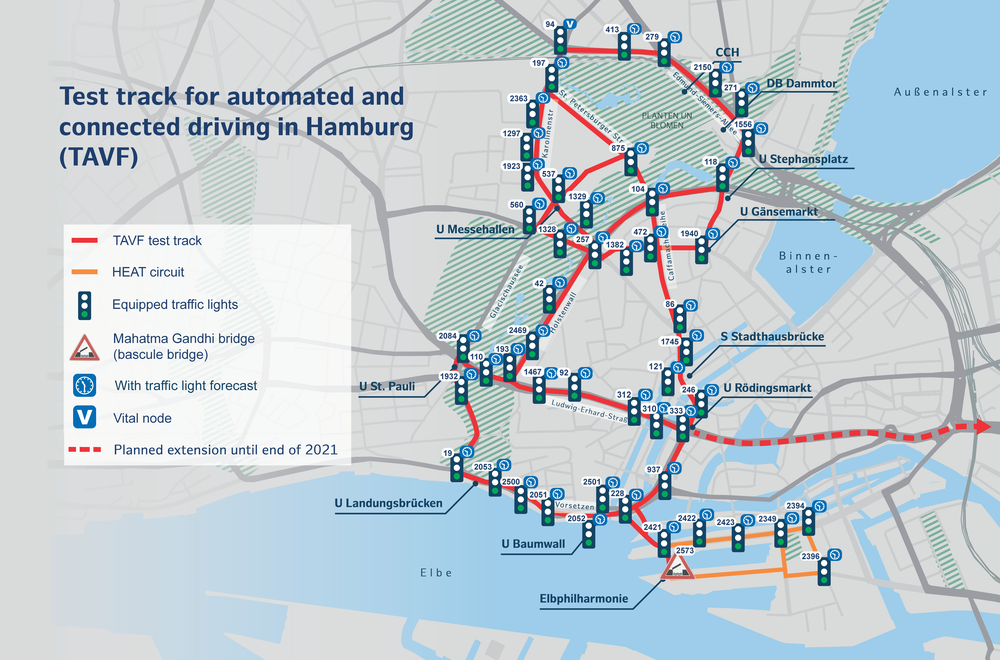Intelligent Cooperative Intersection for Future Urban Traffic in Hamburg
Come and see our Live Demonstration at the ITS World Congress 2021! Register here!
Future urban intersections will have several new functionalities to make traffic safer, more efficient and more environmentally friendly. Communication between vehicle and infrastructure, intelligent signal control approaches and an increased consideration of vulnerable road users (VRU) will play important roles here. The demonstration at the ITS World Congress 2021 presents the implementation of such an intelligent cooperative intersection located in the Free and Hanseatic City of Hamburg and features new actuated traffic light control approaches, which can make use of vehicle-to-infrastructure (V2I) communication, 5G and AI technology for decision making. Furthermore, innovative detection equipment is applied to capture road users, especially VRUs, to provide their trajectories as input for the signal control and for a broadcast via I2V to prevent conflicting and dangerous situations, e.g. as support for future automated driving.

Test intersection Rentzelstr. / Schröderstiftstr. / An der Verbindungsbahn
The intersection no. 94 “Rentzelstr. / Schröderstiftstr. / An der Verbindungsbahn” was chosen to be the test site for the implementation of the novel features. This intersection is part of the Hamburg main road network where an arterial road crosses an important inner-city connection. Two large inner-city parks are located next to it, generating a high demand of vulnerable road users (VRU), which consequently pass the intersection. The intersection is also part of the “Test Track for Automated and Connected Driving in Hamburg” (TAVF) and located next to the Hamburg Exhibition Area of the ITS World Congress 2021.
Cooperative traffic light control
The idea of DLR’s cooperative traffic light control (VITAL) combines a vehicle-actuated green time adjustment with a GLOSA (Green Light Optimal Speed Advisory) application, utilizing a bidirectional V2I communication. The control is sensitive to a fluctuating traffic flow, and broadcasts reliable speed recommendations for approaching vehicles at the same time. Connected vehicles in the vicinity of the intersection are continuously tracked with their current positions and speeds, which are processed to predict their arrivals at the intersection’s stop lines. Based on these predicted arrivals, green times and the phase sequence can be adapted according to the current traffic flow, bounded by a minimum and maximum permitted phase duration. An optimisation algorithm, based on dynamic programming, aims to minimise the sum of overall delay times at the intersection by considering speed adaptations due to GLOSA. The results of this optimisation are individual time slots for each vehicle combined with a recommendation on when to cross a stop line. This information is broadcasted so that connected vehicles can adapt their approaching speeds to meet their individual arrival time slots. The optimisation process is iterative and can be repeated up to every second, while green times and the phase sequence remain fixed for a defined time horizon.
To compensate for today’s rather low V2I utilisation rate and to deploy the new control at the chosen test intersection, the locally existing technical setup had to be adapted and upgraded. This primarily includes FLIR Thermi2Cams and VITRONIC Intelligent Detection and Tracking Equipment (IDTE) to detect road users, as well as a roadside unit (RSU) to communicate with them. By combining the data retrieved from these measuring points, all lanes are observed by forming virtual detection zones, which ensures a continuous detection of all passing vehicles. The prediction of these vehicles trajectories’ is done with the help of the microscopic traffic simulation SUMO (Simulation of Urban Mobility) by inserting them into the simulation in real time and forecasting their further movement. In the future, when the V2I vehicle equipment rate is assumed to be higher, this workaround and these additional sensors for vehicle detection presumably will not be necessary anymore. Due to the additionally installed RSU, the current intersection’s traffic light control could directly switch to a fully operational V2I based control.
Detection of Pedestrians and Cyclists
Detecting pedestrians and cyclists (VRU) poses major challenges, in particular with regards to the correct and reliable identification. In order to reach high levels of VRU recording, the additional VITRONIC Intelligent Detection and Tracking Equipment (IDTE) was installed which allows to distinguish VRUs from other road users and to identify their positions and trajectories. The VRU data captured by the IDTE sensor equipment is submitted to the intersection’s new control method as an input. Moreover, the IDTE will also be used for enhancing traffic safety and to reduce the risk of accidents. Therefore, the IDTE data will be processed to identify potentially dangerous situations between VRUs and other road users. This information will be broadcasted as Decentralized Environmental Notification Messages (DENM) via the RSU to connected vehicles. The scope of the IDTE is not limited to VRUs, thus it also includes all motorised road users.

Intelligent control unit for further applications
The test intersection had also been upgraded with additional hardware to process the collected data and to execute the novel signal control method. The cooperative VITAL control has certain requirements with regard to computing performance that no conventional traffic signal controller has been able to meet so far. Therefore, the previously applied traffic signal controller was extended with an industrial mini-PC (IPC) that serves as a data broker and distributes all information between the intersection’s components. If this IPC would also be integrated into a powerful communication network, like a 5G cloud-based backend, additional applications for traffic light control, like the usage of AI approaches, could become possible. Therefore, the T-Labs of Deutsche Telekom have designed a 5G cloud-capable, AI-based traffic signal control approach. This approach was trained with detection data from the intersection and executed on the local IPC. In the future, however, this service can be provided directly from the cloud, in which case the IPC will only serve as a gateway.

Project participants:






